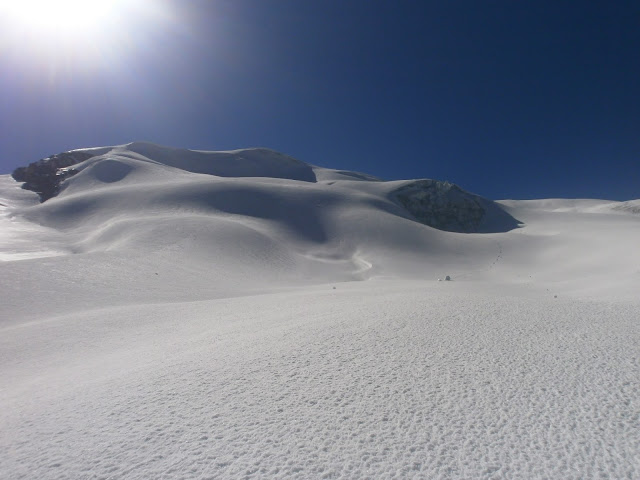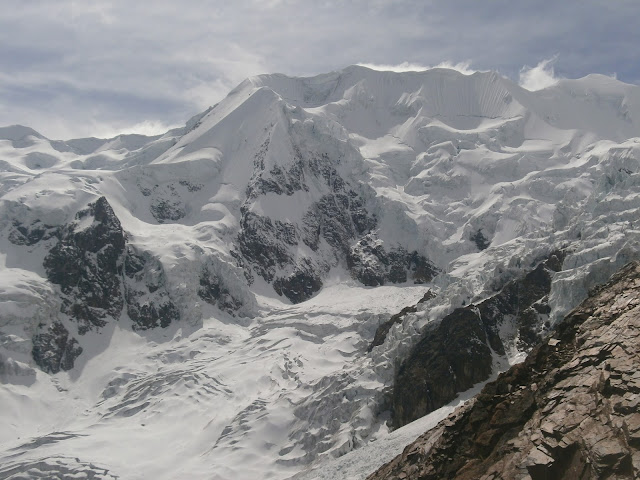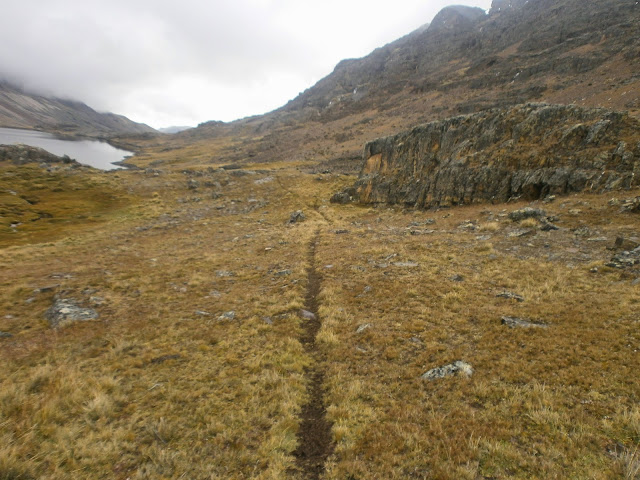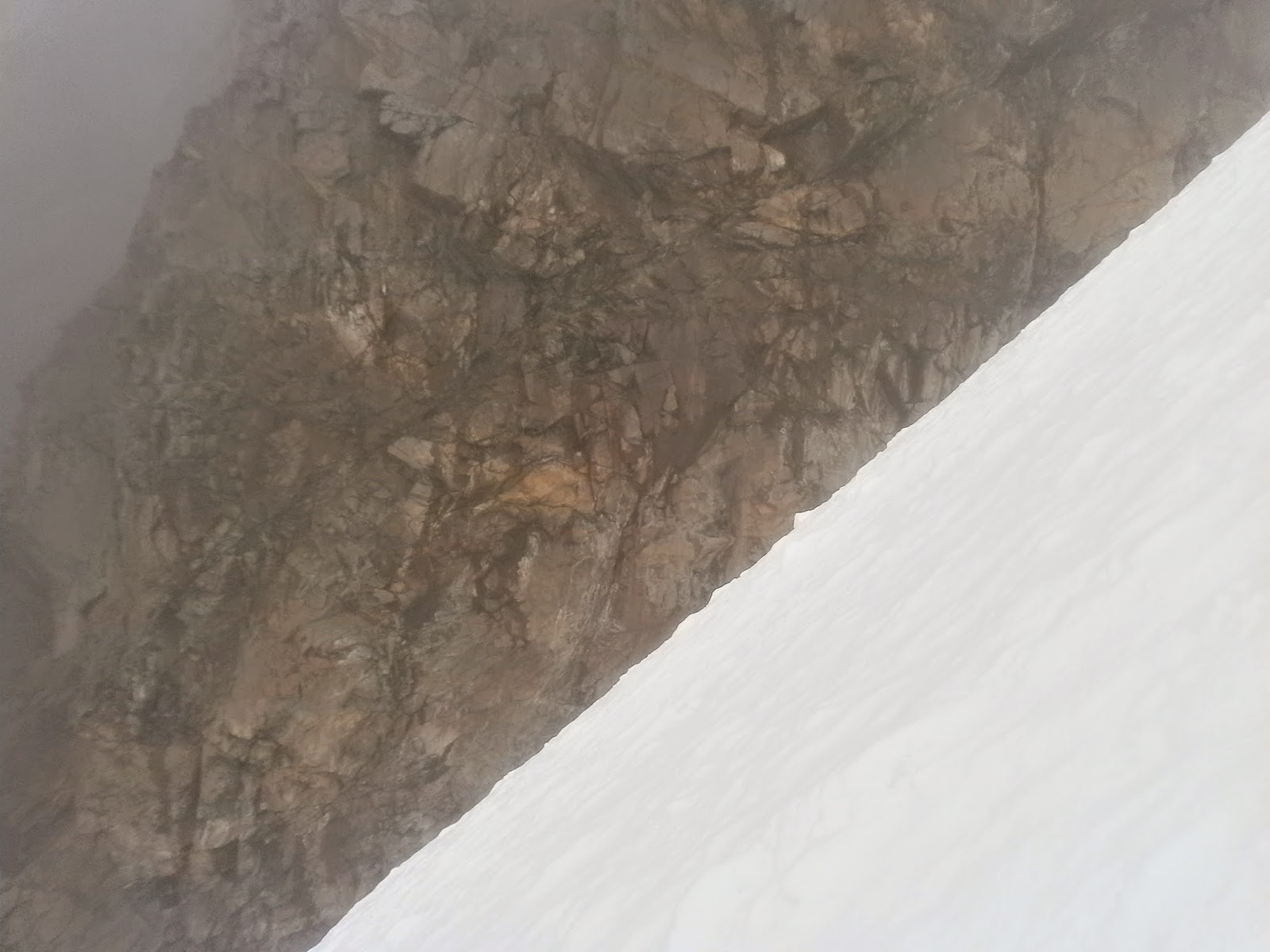After just over 5 hours including a few stops, we were in the sleepy village of Sajama. We stopped there shortly to ask about a mountain hut that is not working but if you find the right person you might get the key to enter the hut. A woman in a hotel said we should try to find señor x around the plaza, who might know more. Instead, we kept on driving toward the mountains ready to spend the night in a tent. The terrain is all soft sand mixed with volcanic ash, and it's like driving on a sandy beach. At one point we got stuck in the sand going up a slight hill, and it took quite a while to get moving again even using 4x4. The other Finn thought my car might have what's in Spanish called "4x4 bajo" which is one more speed or gear while using the 4x4. I thought 4x4 was either on or off, but in fact learned that there is more to it, and that's how we got out of the sand and I turned the car around and drove back a little bit on top of a small hill. Now we most likely would have been able to clear the hill where we got stuck, but I was a little bit worried about the engine overheating because it had taken great efforts to get out of the deep sand. Also we believed the base camp and the mountain hut were not far. One estimate was that it was 1 kilometer away! So we started walking in the soft sand and very strong wind and with very heavy backpacks and a lot of bottled water from 4415 meters/ 14,500ft of elevation. We were quite hopeful that the walk wouldn't very long and after about 1,5 hours we were getting a little bit tired. Our goal was to get to the hut to be able to rest and eat next to it, protected from the wind and then keep on walking higher to camp. But hours passed and we never saw it. Suddenly it got really cold when the sun disappeared behind the mountain and we were at 5100m/ 16,700ft. There was a big rock behind which we thought we might have to camp even though it was not a flat area. Me and Javier decided to leave our backpacks and take a last look just a little bit further, just in case we would see a better camp spot. After about 400m of walking he saw the hut among huge rocks, and we returned to our backpacks to walk the last hundreds of meters of the hard day. In the end we had walked 7,1km or 4,5 miles with super heavy loads gaining over 700m of altitude in the soft sand.
Then Javier, who arrived first, tried the door and it was open! We couldn't have been happier or more surprised. The hut had 8 bunk beds, water and gas for cooking, and electricity from a solar panel. Needless to say it was a lot warmer inside than outside in the wind. The rocks outside around the hut were about the size of a cargo van and much bigger, with mostly very straight lines and would have provided some shelter from the wind, and the sand might have been nice and soft for sleeping, but there is nothing like getting to sleep inside in a bed after a hard day when it's cold and windy outside. Not to mention how much space we had inside. We ate and then went to bed at 7.45pm. As expected, I didn't sleep much, maybe 3-4 hours of really being asleep. In the night the clear sky was incredibly full of stars. My buddies slept about 10 hours which time I also spent in my sleeping bag. It was quite late 6.30 am when we started the walk toward the snow and the top.First it was about an hour in the sand, then when it got steeper, it was better to walk and climb over rocks instead of the soft sand. It took hours for us to get close to the snow. Because it's November and it has not been snowing much in months, the snow has been burned off by the sun until very high on the mountain. I think the snow started at 5800m 19,000ft. There the other Finnish man had to stop and go back down. The neighboring Pomerape had snow from about 5300 meters or 17,400ft at least on two southern slopes so maybe Parinacota too had more snow on its other sides. At first it was great fun going up or around the nieve penitentes that were about 1 meter tall or less but of course it was really slow and tiring too. Again it took hours to get to the next stage which was icy ladders. I'm glad it was like that and not straight ice.
The last step was 20 vertical meters loose rocks. This was a lot harder than I thought and very slow because there was a thin layer of quite small rocks on top of a surprisingly hard ground, so it was slippery. Eventually I got to the crater rim to wait for Javier who got up 15 minutes later still in his crampons. I should have done the same instead of taking them off. On the top it was windy and there were some snow lines. First we went to the left and then to the right while looking for the highest spot and my gps showed 6347 meters 20,820ft.
I'm not sure we stood on the highest spot, maybe not, but that's ok. The ascent took so long because there was so little snow, and no good snow at all. We didn't have the energy or the time to walk the whole crater. After almost exactly 12 hours we were back at the hut, exhausted. Ate and went to sleep before 8 without a clear plan for the next day but it was our goal to attempt also Pomerape which is almost as high and over 6200 meters . Again, everyone slept or rested for about 9,5 hours. In the morning I felt terribly tired and generally bad, and so did Javier who had been a little sick, and Jari was perhaps in the best shape of us. We "decided" to go for Pomerape, but gave up before leaving the hut : D It was just impossible. I had slept really poorly and very little for the last three nights. Had we arrived all the way to the hut in a car, we would have been in much better position, but now the first day's walk had been a lot for us. I barely made it to the car that day in about 2,5 hours. At least one total rest day would have been required for us to try Pomerape, probably two days of just resting. So, walking 7km to the car was no rest and the next day should have been a rest day, but we went home. Maybe there will be one more trip to those mountains later.


















































